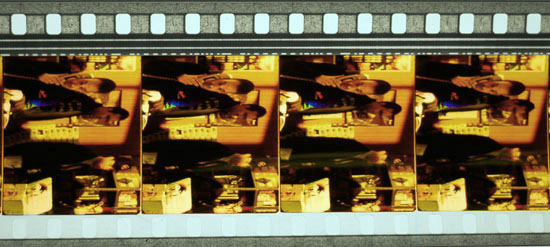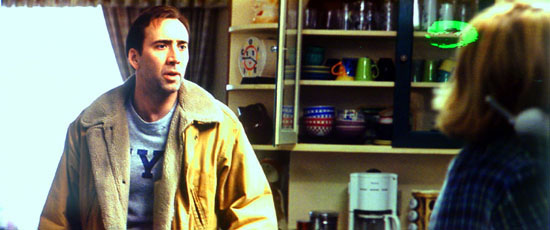Cinema Product Reviews
Technicolor Labs' Dye Transfer Printing Process
Manufacturer: Technicolor Labs, California
Rating: A+
Reviewed December 2000 by Brad Miller

What? A review that earns an A+??? Yes, you read that correctly. The fine folks at Technicolor Labs have brought back the old "IB" technology and updated it for current film printing.
Back in the 1930s, the term "Technicolor" actually referred to an imbition process whereas the movies were filmed using a special camera that would photograph the image onto 3 strips of film simultaneously, all from the same single lens on the camera. Each film recorded one of the three primary colors via filters in the camera. Those strips of film were then taken to the lab and soaked in magenta, cyan and yellow dyes. From this point, each strip could then be contact printed to an unexposed stretch of black and white film, resulting in a single finished color print. While this may seem like a LOT of work just to get color, back in the mid 1900's it was the only way. The resulting images had incredibly well saturated colors, blacker blacks, whiter whites and their colors would never fade over time. Once color film negative stocks were invented there was no need for the 3 strip Technicolor camera, but IB "printing" from the single strip color negatives continued for some time. Unfortunately in the 1970s, the IB process was abandoned for more economical printing.
But it's back! Anyone who has seen one of the latest prints turned out by the Technicolor lab knows precisely what I am talking about. Although early attempts to bring back a revised "dye transfer" (it's not called "IB" anymore) means of printing were plagued with problems, the wizards at Technicolor Labs have since worked out the bugs and their resulting limited prints over the last year have been nothing short of spectacular.
Early attemps to revive the dye transfer process of printing were tested with the releases of "Bulworth" and "Gone With the Wind". For anyone who saw or ran one of these prints, it is known that there were various issues such a the "matrix" of colors not lining up properly and extreme print shedding and sticking. Since then more recent releases such as "The 13th Warrior", "Toy Story 2", and "The Family Man" have proven that the process deserves much credit and respect.
I got the chance to compare side-by-side prints of "The Family Man". The first print was from the Technicolor lab and was dye transfer printed. The second print was from the Deluxe Hollywood lab and was printed in their normal fashion. Needless to say, the difference was astonishing.
So how do you tell a dye transfer print from a regular print?

Above is a shot of a regular release print. Below is an identical scene from a dye transfer release print.

One can tell a dye transfer print right off of the bat by physically inspecting the film itself and noting it's black and white edges. Remember, the print stock is in fact black and white film...NOT color. This is why the edges of a dye transfer print (notably the SDDS track) are not colored.

Another way to tell a dye transfer print is by the reel end cue marks. They are green.
But of course the most obvious way to tell the difference is simply to look at the image on screen. Although the pictures below are not magnified to normal proportions, even with these quick photographs of the film on the rewind bench one can see the incredible difference in relation to color saturation and extended latitude. Colors are deep and richer and as I stated before, the blacks are blacker and the whites are whiter. It makes overall for a very vivid image, somewhat similar to the difference in comparing a matt white screen to a silver screen.
So what else can I say? There's not too much else to say except that the next time rumor starts floating around about Technicolor printing limited prints of a movie in dye transfer...call your booker on a daily basis until he can get you one for YOUR theater. It's presentation at it's absolute best!